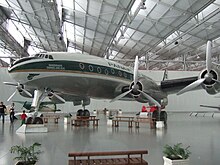Panair do Brasil Flight 099
 Lockheed Constellation similar to the destroyed specimen, painted with the colors of Panair do Brasil, on display at the Wings of a Dream Museum in São Paulo. | |
| Accident | |
|---|---|
| Date | 28 July 1950 |
| Site | Morro do Chapéu and Morro das Cabras between Sapucaia do Sul and Gravataí, Rio Grande do Sul, Brazil |
| Aircraft | |
| Aircraft type | Lockheed Constellation |
| Operator | Panair do Brasil |
| Registration | PP-PCG |
| Destination | Canoas Air Base |
| Passengers | 44 |
| Crew | 7 |
| Fatalities | 51 |
| Survivors | 0 |
The Panair do Brasil Flight 099 was a flight that suffered a serious air accident on July 28, 1950.[1]
Aircraft
[edit]The Lockheed Constellation, serial number 2062, was manufactured in mid-1945 at the Burbank plant in California. The aircraft, which had been ordered by Pan American World Airways and was to receive the registration NC88862, in fact, did not serve the American company. It was sent to Panair do Brasil (at the time controlled by Pan Am but already in the process of transferring shares to Brazilian controllers), where it received the prefix PP-PCG. It inaugurated the Brazil-Italy Flight on October 3, 1946, between Rio de Janeiro and Rome with stops in Recife, Dakar, and Lisbon, covering 5,339 miles in 24 hours.[citation needed]
Accident
[edit]Panair do Brasil Flight 099 took off from Galeão Air Base at 15:47, six hours before the scheduled departure time, due to a defect in one of the aircraft's engines, which had to be replaced and tested in an inspection flight. The landing was to take place at Canoas Air Base (then known as Gravataí Air Base) on the outskirts of Porto Alegre at 18:40.
The Constellation with the prefix PP-PCG carried 44 passengers (many of whom were on vacation in Rio de Janeiro, which had hosted the 1950 World Cup) and 6 crew members, piloted by Commander Eduardo Martins de Oliveira (about to complete 10,000 flight hours in his career, he was known as "Comandante Edu," one of the founders and standard-bearers of the famous "Clube dos Cafajestes").[2]
According to weather reports, there was a stationary cold front between Porto Alegre and Florianópolis, causing heavy turbulence and light rain in the capital of Rio Grande do Sul.[citation needed]
After some delay on the route, caused by unfavorable weather conditions, the Constellation began the approach procedures to land at Canoas Air Base at 18:45. However, the landing was aborted, followed by a go-around. During the second landing attempt, contact with the tower was lost, followed by another go-around. Subsequently, the Constellation crashed into Morro do Chapéu (currently located between the municipalities of Gravataí and Sapucaia do Sul) around 19:25, exploding shortly after.[citation needed]
The explosion caused a fire in the area two hours later.
Due to the difficult access to the area, rescue teams took two hours to reach the wreckage, finding all crew and passengers dead. The work of removing the bodies and clearing the area, commanded by then-Colonel Olímpio Mourão Filho, took several days due to the extent of the area covered by the debris.[citation needed]
Aftermath
[edit]At the time of the accident, many flights were directed to Canoas Air Base because it had long, paved runways capable of accommodating large aircraft like the Constellation, but it operated only under visual conditions. In contrast, the São João airfield, located in Porto Alegre, had instruments to facilitate landings but did not have paved runways.[3]
The shock generated by the disaster was such that the São João Airfield was renamed Salgado Filho Airport, and the improvement works that had been halted during World War II were resumed. As a result, Salgado Filho Airport was equipped with a new passenger terminal and paved runways, eliminating the difficulties of operating large aircraft.[citation needed]
It was then considered the worst air accident in Brazil.
Two days after the incident, politician Joaquim Pedro Salgado Filho died in another air accident in Rio Grande do Sul, having not boarded Flight 099 due to a lack of seats.[citation needed]
Composers Fernando Lobo and Paulo Soledade wrote the song "Zum-zum," in honor of "Comandante Edu," performed by Dalva de Oliveira at the 1951 Carnival.[citation needed]
References
[edit]- ^ "Viamão and the connection with the tragedy of Panair do Brasil Flight 099". Gazeta de Viamão. 2019-06-11. Retrieved 2020-11-24.
- ^ Gonçalves, Sérgio (2010-12-27). "Direto do Cockpit: Morro do Chapéu". Direto do Cockpit. Retrieved 2020-11-24.
- ^ "History of Salgado Filho International Airport". Infraero. Retrieved 2020-11-24.
